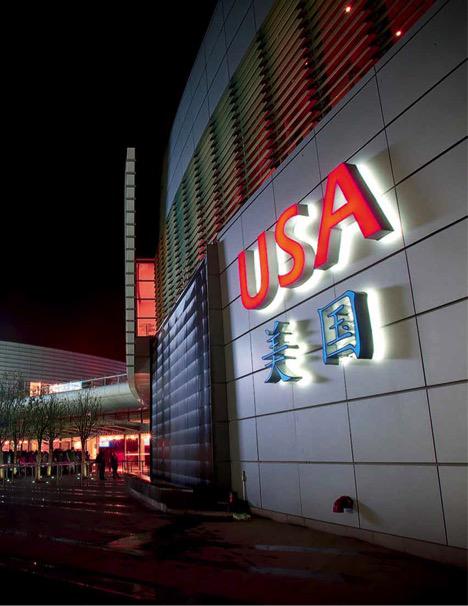The Expo was clearly important to China, and the US relationship to China was important to the US – therefore, the US should be in Shanghai. — Nick Winslow
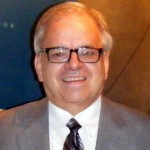
As the US Pavilion for Milan Expo 2015 continues to take shape, InPark Magazine continues its “Tales from the Expo” series on US participation in world’s fairs in an exclusive series of articles by James Ogul. Since retiring from the US State Dept in 2011 after a 30+ year career in world expos, Ogul has remained on the scene in an advisory and consulting role. Previous stories covered Taejon ’93, Lisbon ’98 and Hanover 2000, the 1992 world expos in Seville and Genoa, Tsukuba ’85, Vancouver ’86 and Brisbane ’88, Knoxville ’82 and New Orleans ’84. and Aichi 2005. Ogul’s next article will cover the US Pavilion at Yeosu Expo 2012.
This article, originally published in September 2014, is part of “Tales from the Expo,” an InPark Magazine online book written byJames Ogul and edited by Judith Rubin.
[dropcap color=”#888″ type=”square”]E[/dropcap]xpo 2010 in Shanghai, China, was held May 1-October 31, and its theme was “Better City – Better Life.” This was the first world’s fair ever held in China and it was huge – in many ways.
–Participation: Shanghai 2010 boasted 192 international participants. For comparison, here are participant numbers from previous expos: Aichi 2005 (121), Hanover 2000 (180), Lisbon (148), Zaragoza 2008 (104), Lisbon 1998 (148), Taejon 1993 (141), Seville 1992 (108), Brisbane 1988 (35), Vancover 1986 (108), Tsukuba 1985 (111).
–Visitation: The number of visits was also a record breaker at 73 million. Osaka 1970 was the previous record holder with 64 million visits. Crowds were so large at Shanghai 2010 that one day saw a million visits on the expo grounds.
–Area: The 1,300-acre site was the largest in world’s fair history. Osaka ’70 had a site of 820 acres. Shanghai’s 1,300 acres seems to have just beaten out the Saint Louis 1904 world expo, which has been recorded at 1,272 acres.
Supplement: See more photos, videos, sponsor lists and team lists in connection with the USAP at Shanghai Expo 2010.
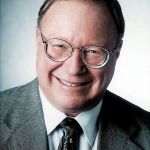
State Department gives the green light
The US State Department issued a Letter of Intent on March 18, 2008 to Nick Winslow and Ellen Eliasoph, authorizing them to raise all of the necessary money for the pavilion. The funds would need to cover building design and construction, exhibit design and construction, offices and equipment, as well as staffing, operations and eventual disposal of the pavilion and its contents (it was torn down after closing day). The original budget estimate at the time the Letter of Intent was issued was $84 million. “In the next few months we determined that the $84M goal could not be met and we reduced the budget to $63 million, which turned out to be a prescient move,” said Winslow. “We hit the target and were able to save a little in both construction and operations, which meant we didn’t have to use all of our contingency money and resulted in a surplus.”
What spurred Winslow and Eliasoph to pursue this venture and present themselves to the State Department? It seems that the catalyst was simply seeing the need and knowing their unique capacity to meet it. Winslow is a recreational facilities and services consultant and contractor with a background in visitor attractions and feasibility analysis. Eliasoph is an attorney with relevant experience in government, the attractions business and Asia (she is currently president and CEO of Village Roadshow Entertainment Group Asia).
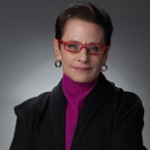
In his own words: “My effort to realize a US Pavilion for the Shanghai Expo began during a conversation with my old friend Ellen Eliasoph in December 2007,” said Winslow. “Ellen and I had worked together at Warner Bros., specifically on a project in China. Now, we commiserated on the status of the US Pavilion effort in Shanghai, which was going nowhere at the time due to a failed RFP process. Subsequent conversations with the US Consulate in Shanghai, the American Chamber of Commerce in Shanghai, the Shanghai Expo Authority and ECA [Bureau of Education and Cultural Affairs] at the State Department in Washington DC convinced us that a serious effort to bring about a US Pavilion was a worthy if risky endeavor. We knew that lack of time and funding could result in failure but believed an honest effort should be made so the US would not suffer the embarrassment of being the only major nation in the world not to be represented in Shanghai. The Expo was clearly important to China, and the US relationship to China was important to the US, therefore, the US should be in Shanghai. Hardly rocket science.”
He was right. Back at the State Dept., with the RFP process having failed we were contemplating the possibility of not participating at Shanghai. This new proposal provided a possibility of saving the effort. But upwards of $60 million had to be raised. “Our initial [fundraising] efforts were not very successful,” said Winslow. “We had a very small amount of money to do some initial planning and conceptual work but were out of funds by mid-2008. We were also impacted by the recession, the national elections and the Beijing Olympics. Potential sponsors would not commit to the pavilion in light of the uncertainties of the time.”
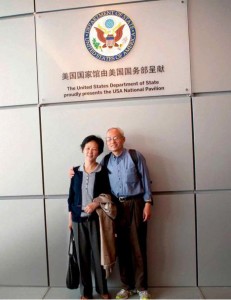
Together, Winslow and Eliasoph formed an excellent leadership team for the pavilion, able to recognize and address the needs of the project immediately, which was especially good considering that just a little over 27 months remained until opening day. The project was on a very tight time schedule given the requirements of designing and constructing a building from the ground up as well as the exhibition.
As Program Officer in my role for the State Department, my work included serving as a member of the Shanghai Working Group and advising our office director on management of the program. I also coordinated the vetting of 400 potential pavilion sponsors, and reviewed submissions by the private sector partner.
Fundraising and uncertainty
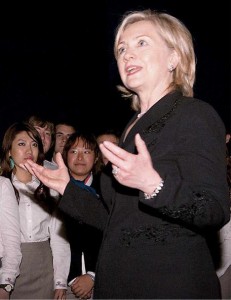
I remember those days well: The weekly teleconferences fell into a pattern: First, there would be good news about a potential sponsor; then, it wouldn’t work out. The initial seed money was running out and there were no new sponsors. But the 2008 presidential election made a difference. With the new administration came renewed interest in supporting the US Pavilion effort. The new Secretary of State, Hillary Clinton, set up a group inside the State Dept. to support the effort, and named a Commissioner General, Jose Villarreal.
“We began picking up steam, but time and money continued to be problems,” said Winslow. “I was not certain we would have sufficient funding to complete the Pavilion, until two months prior to opening day. And then, I wasn’t certain that we would have sufficient funding to keep the Pavilion open for the duration of the Expo, until one month before opening. Basic building systems like air conditioning, and the show systems for the major exhibitions, did not come online until after the soft opening week. Thanks to the terrific effort by our project management team, and our operations team headed by Mark Germyn, we opened on time and on budget, and even had a small surplus at the end of the Expo, which we donated to the State Department.”
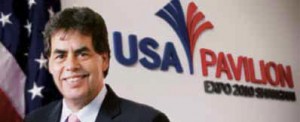
Secretary Clinton’s hands-on approach was unprecedented in my experience. We had never before had direct involvement by a Secretary of State, and I think it made all the difference in turning the fundraising effort around. “All-in-all it was a very difficult project with many daunting obstacles,” said Winslow. “Most of my peers thought we would fail and were crazy for taking on such a forbidding task. I am particularly proud of the success of our Student Ambassador Program, our outreach efforts and our public diplomacy work. I believe they will have long-term benefits to the US and our relations with China. It was a roller-coaster ride, but I am glad we took the chance and that the US played a significant role in the largest event in history.”
For my own part, I was greatly impressed by the entire team effort on this expo pavilion. Their dedication and professionalism, coupled with ability and experience, were incredible – it was one of the best teams I’ve encountered in more than 30 years of working on such projects.
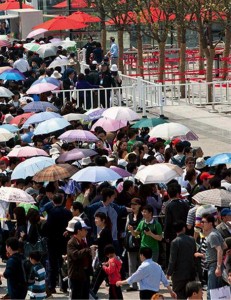
With the help of the State Department and in particular, Secretary of State Clinton, Shanghai USA 2010 (the non-profit corporation created by Winslow and Eliasoph) raised a record $63 million. Kris Balderston who headed the Gobal Partnership Initiative for the State Department said, “With a challenging timeframe of only 10 months, we worked closely with Secretary Clinton to demonstrate the importance of this unique public-private endeavor in representing the best of America under one roof.” The surplus of approximately $3 million was put to good use – see the Legacy section at the end of this article. The New York Times reported on Clinton’s efforts for the USAP in this January 2010 story.
I met with Balderston and his team every week in the run-up to opening, and the reports from GPI on the status of fundraising were the most-awaited part of each team meeting. More than 400 corporations were approached and participation agreements were signed with 68 official sponsors and 16 official suppliers. I know there were 400, because among other things I had to coordinate the vetting of all sponsors through several branches of the State Department. It was the biggest vetting process we had ever had. The 68 sponsors did much more than donate funds. They designed, built and installed exhibits, filling one entire gallery of the pavilion, and conducted more than 200 business forums, press conferences, and customer and employee meetings at the pavilion, promoting trade and investment.
The Building
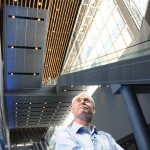
Vancouver-based architect Clive Grout, of Grout McTavish Architects, was recruited to design the building. Grout got his start with world’s fairs, appropriately enough, at Vancouver Expo 86 and went on to do many others, as well as other projects that accommodate high public traffic, such as airport terminals. The USA Pavilion (USAP) measured 64,580 sq. ft. and stood 56.8 ft. at its highest point, making it one of the largest such in recent history. For comparison, the US Pavilion at Aichi 2005 was less than half that size, and the US Pavilion at Lisbon ’98 was a little smaller than Aichi. You have to go back to Seville ’92 for anything comparable: the US Pavilion at Seville had 55,000 square feet of space under its roof.
The USAP at Shanghai 2010 had a very functional two-story design with exhibitions on the lower level and offices, conference rooms and a VIP lounge on the upper floor. In addition, it was a green, carbon-neutral building. This was achieved through carbon-offset purchases that canceled out the Pavilion’s CO2 emissions. Sustainable materials were used in its construction, including recycled bamboo flooring. The carefully considered placement of the building and its glazing reduced exposure to the sun, decreasing the heat load in the building and limiting the energy needed to cool it. Centrally produced chilled water avoided the need for on-site specific cooling plants, which saved additional energy. A solar hot water system warmed the Pavilion’s water supply. Recessed sections of landscaping around the building collected rainwater, allowing it to seep straight into the ground, preventing run-off. Moreover, the building had a roof garden supporting biodiversity and demonstrating how people can grow food where they live, even in urban environments. The Pavilion’s garden included citrus trees, herbs, vegetables, and grape vines. The entry courtyard included 50 mature camphor trees cooling the environment for pavilion visitors. Photovoltaic cells converted sunlight into electricity, and powered the main USA sign near the Pavilion’s waterfall.
The Exhibition
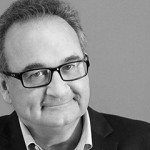
Entry Plaza
As visitors waited to enter the Pavilion, bilingual Student Ambassadors greeted them, images appeared on a large LED screen, and periodic performances occurred on a nearby stage. Due to the long queue lines, the Student Ambassadors developed routines to entertain the crowds to make the wait more enjoyable – this was something the students recognized as a need, and pro-actively filled without being coached to do it. For most of the visitors this was their first interaction with an American.
Overture: “Welcome to America!”
Once past the turnstiles, guests moved into the Overture Room where they were welcomed by Student Ambassadors. There was an Honor Wall, listing the sponsors who helped make the Pavilion possible. Several large screens showed an array of American images: the Grand Canyon, a little league baseball game, plus other iconic shots. A video presented everyday Americans attempting, sometimes with humorous results, their greetings in Chinese, as well as greetings from basketball legends Kobe Bryant and Magic Johnson, figure skater Michelle Kwan, the Laker Girls cheerleading squad, skateboarder Tony Hawk, and US Ambassador Jon Huntsman,Jr., and his wife, Mary Kaye. At the conclusion, U.S. Commissioner General José Villarreal welcomed visitors to the U.S. Pavilion.
Act 1: Spirit of America
In this section, three giant, high-definition screens showed a mix of American people candidly talking about how to make the world a better place. Secretary of State Hillary Rodham Clinton opens the presentation. Then, educators, business people, community leaders, and children offer their thoughts on the future. Before the presentation ends, President Barack Obama welcomes Pavilion guests on behalf of the American people. President Obama’s welcoming address is still available years later for viewing on China’s largest online video sites.
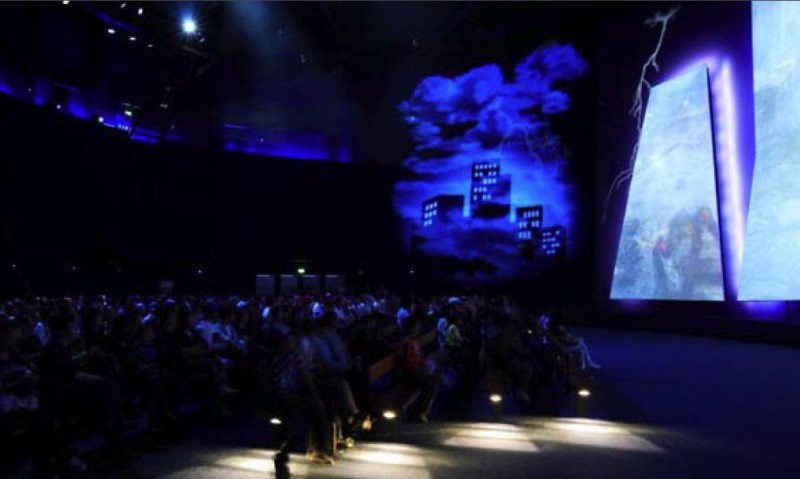
Act 2: “The Garden”
The Pavilion’s main event in the next gallery was projected on five, towering screens. “The Garden” was an immersive, eight-minute experience produced by BRC Imagination Arts. The urban fairy tale followed a little girl’s dream to transform a vacant lot into an urban garden. As the audience watched the girl try to achieve her goal, dazzling lights, 360-degree sound, and 4-D effects took place throughout the theater. The skyscraper-shaped screens not only revealed the story frame-by-frame, but also turned into bus stops, windows, skyscrapers, and other backdrops. “Best of all,” said BRC’s Bob Rogers (whose company’s work on expo exhibits is well known and reaches back to 1986) “this story is told without a word of dialog. Through moving images, music, and sound effects, our story speaks to everyone no matter what their native language may be.”
Act 3: Opportunity and innovation
Rounding out the experience were four themed zones highlighting America and its future-focused efforts in the areas of sustainability, health and nutrition, technology, and a broader category called “Connecting Our World.” The curving, 6,000 sq ft walk-through space contained media-driven and interactive displays from more than 25 sponsors.
Electrosonic provided AV systems to the USAP at Shanghai 2010: click here for story and more images.
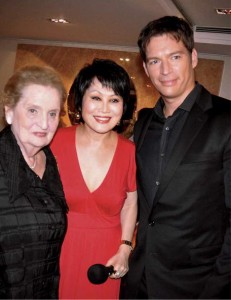
Cultural Performances
The USA Pavilion had over 1,000 performances by over 100 different performing groups – including four Grammy winners. Performers ranged from Hawaiian hula dancers to the United States Army’s 25th Infantry Marching Band, to Harry Connick Jr., Ozomatli, Herbie Hancock, Dee Dee Bridgewater, and Chinese-American indie rock group PaperDoll.
National Day
On July 2, 2010 the USAP held its National Day, and welcomed a Presidential Delegation led by former Secretary of State Albright. The day featured performances from the University of Southern California’s Marching Band, folk singer Abigail Washburn, soprano Angela Brown, and Grammy winner Harry Connick Jr. The morning protocol ceremony audience was composed of Americans, Chinese, and special guests from other pavilions.
In the evening, the US Consulate hosted a reception at the USA Pavilion in honor of National Day. Among those in attendance were the Presidential Delegation, USA Pavilion Board of Directors, pavilion sponsors, Chinese Expo Bureau officials and guests from other pavilions. An evening concert featured Harry Connick Jr. The evening also featured an appearance by Rima Fakih, Miss USA, and a performance by the USC Marching Band.
Student Ambassadors
US Pavilions have always been characterized by outgoing and knowledgeable guides interacting with pavilion visitors. Shanghai Expo 2010 President Nick Winslow came up with a new name for the guides – Student Ambassadors, which has been the name used ever since. It is an appropriate title as these young university students were the face of the US Pavilion to its millions of visitors. The Student Ambassador program was managed by the US-China Institute of the University of Southern California. The Student Ambassadors, a group of 160 Mandarin-fluent university students, from 38 U.S. states and 84 American universities, were key to the Pavilion’s public diplomacy. They interacted with visitors throughout the pavilion and took on assignments in its offices and administration.
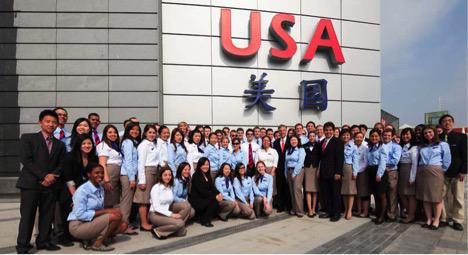
The Student Ambassadors helped welcome Chinese President Hu Jintao, Secretary Clinton, Secretary of Commerce Gary Locke, former US President Jimmy Carter, 10 U.S. state governors, and the former Secretary of State Madeleine Albright. In addition, five specialized teams were created, and each Student Ambassador spent 36 days of their three-month tour of duty on one of the teams. The Entertainment team helped manage the various shows and talents hosted by the pavilion on the pavilion stage and at other venues on the expo grounds. The Communications team worked with journalists covering the pavilion and coordinated interviews with pavilion staff. The Protocol team worked on high level visits by dignitaries. The Sponsorship team worked with 65 corporate and state sponsors to plan events and help implement benefits packages. The Community Outreach team created outreach opportunities such as school restoration projects.
The Student Ambassadors’ Community Outreach programs set a new standard for what a US Pavilion can achieve, not only at the expo itself but in the surrounding community. The numerous outreach projects won praise from Shanghai and its neighbors.
Outreach projects included:
Kiddie Korner: The USA Pavilion partnered with local schools, orphanages, and NGOs to treat disadvantaged children to “A Day at the Expo.”
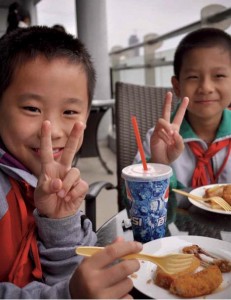
Junior Achievement: The USA Pavilion partnered with Junior Achievement China, the American Chamber of Commerce in Shanghai, and several sponsors to support “The Junior Achiever Green Innovation Challenge.”
Students in Free Enterprise (SIFE): In collaboration with SIFE, the USA Pavilion hosted two events where SIFE teams presented their award-winning projects to a panel of Student Ambassadors and sponsors. Each team received feedback in preparation for a global competition.
Habitat for Humanity: In partnership with Habitat for Humanity, staff and Student Ambassadors as well as US Consulate staff volunteered to demolish and rebuild a dilapidated family home in Zhejiang Province.
“Visit Plus” Days: In partnership with the U.S. Consulate General in Shanghai, 800 Chinese elementary, high school, and university students as well as NGO groups, special needs children, and young student journalists were brought to the USA Pavilion.
State Involvement
One tradition of US Pavilions at world’s fairs is inviting US States to participate. At Shanghai, the states of Texas, Tennessee, and Hawaii were involved – as well as the cities of San Antonio, Houston, and Chicago. And there were visits by governors from seven other states promoting investment and tourism.
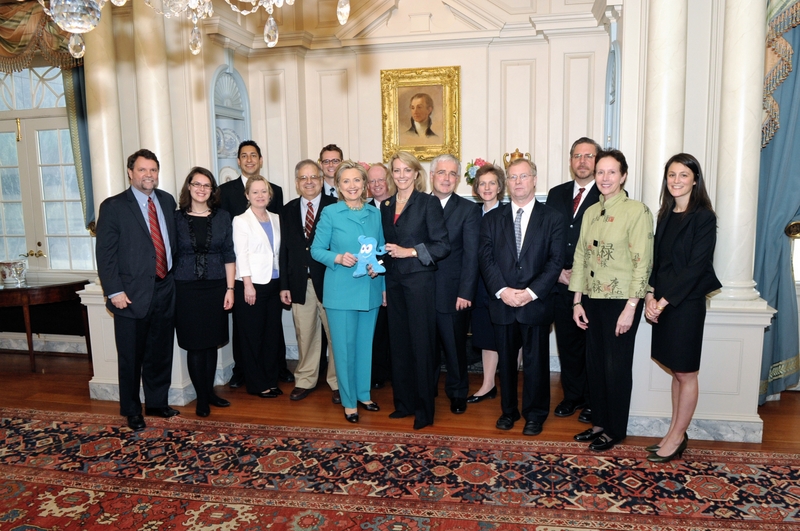
Legacy
The USA Pavilion at Shanghai 2010 was featured in more than 8,000 media stories in China, the U.S., and worldwide. It was estimated that news about the USA Pavilion reached 90 percent of China’s population via China Central TV and other national carriers. The virtual USA Pavilion website hosted an additional 8.8 million online visitors.
7.36 million visits were recorded at the USAP for the duration of Shanghai Expo 2010 – an average of almost 40,000 visitors a day. In addition to the audiences moving through the turnstiles, the USAP hosted US federal, state, and city government officials, including four Presidential Cabinet members, 10 members of Congress, 10 state governors, and 16 mayors. Leaders from all corners of China – every province, autonomous region, and major city – came to the pavilion along with leaders from 160 nations and international organizations.
After the Expo, our public affairs office at the US Consulate in Shanghai continued to distribute DVD copies of “The Garden,” the main show at the USAP. It remains available on the Chinese video site, Youku.com, allowing millions more to experience the main themes of the USAP. The Consulate even sent copies to Kabul at the request of the wife of the ambassador to Afghanistan, who was moved by the self-help, civil message of the movie when she toured the pavilion with Afghani contacts.
Honors for the USAP included the 2010 Gold Standard Award for Country Promotion from Public Affairs Asia Ltd.
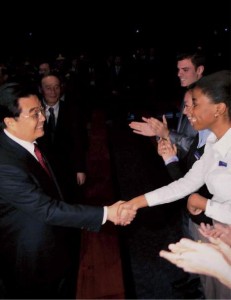
A research study by Fudan University’s School of Management indicated that the USA Pavilion at Shanghai Expo 2010 improved perceptions of America, American culture, and American businesses among the Chinese who visited the Pavilion. Among the findings, 95 percent of visitors felt their visit to the USA Pavilion “was worth their time and effort” despite the long queue line (a common issue for all pavilions at the expo) and 92.4 percent felt “Chinese corporations should use American corporations as role models.”
In the words of one woman from Nanchang, “The more we learn about American culture, the more we appreciate it.”
As Bea Camp, Consul General of the US Consulate in Shanghai and an active participant in the planning and operation of the USAP, wrote in an article published in 2011 in the Public Diplomacy Council, “Welcoming as many as 50,000 visitors a day, the USA Pavilion provided an unprecedented opportunity to showcase American culture and values to the Chinese people. By the end of the Expo on October 31, 2010, the USA Pavilion had presented America’s story and America’s spirit to more than 7 million visitors. Many Chinese visitors were particularly struck by the video greetings of President Obama who welcomed them to visit the United States. They watched attentively as the President noted that ‘we are bound by our common humanity and our shared curiosity. This includes the hopes we share with the people of China and the people around the world, to work together to realize a healthy, sustainable and prosperous future.’” A transcript of Bea Camp’s 2011 talk to the Public Diplomacy Council, which formed the basis of the article, is available here.
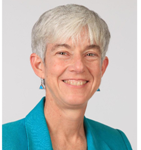
After closing day, the pavilion itself was sold to a Chinese investor who intended to harvest key elements for use in a personal museum. As mentioned above, fundraising brought in $63 million and the budget for the USAP was $60 million. Part of the $3 million budget surplus went to funding for a future Chinese Garden at the National Arboretum in Washington, DC, and part was used to kickstart the US Pavilion at the next world’s fair: Yeosu Expo 2012 in Korea (to be covered in my next article). In appreciation of their contributions via the surplus, all sponsors of the USAP at Shanghai were acknowledged on a plaque displayed in the US Pavilion at Yeosu.


